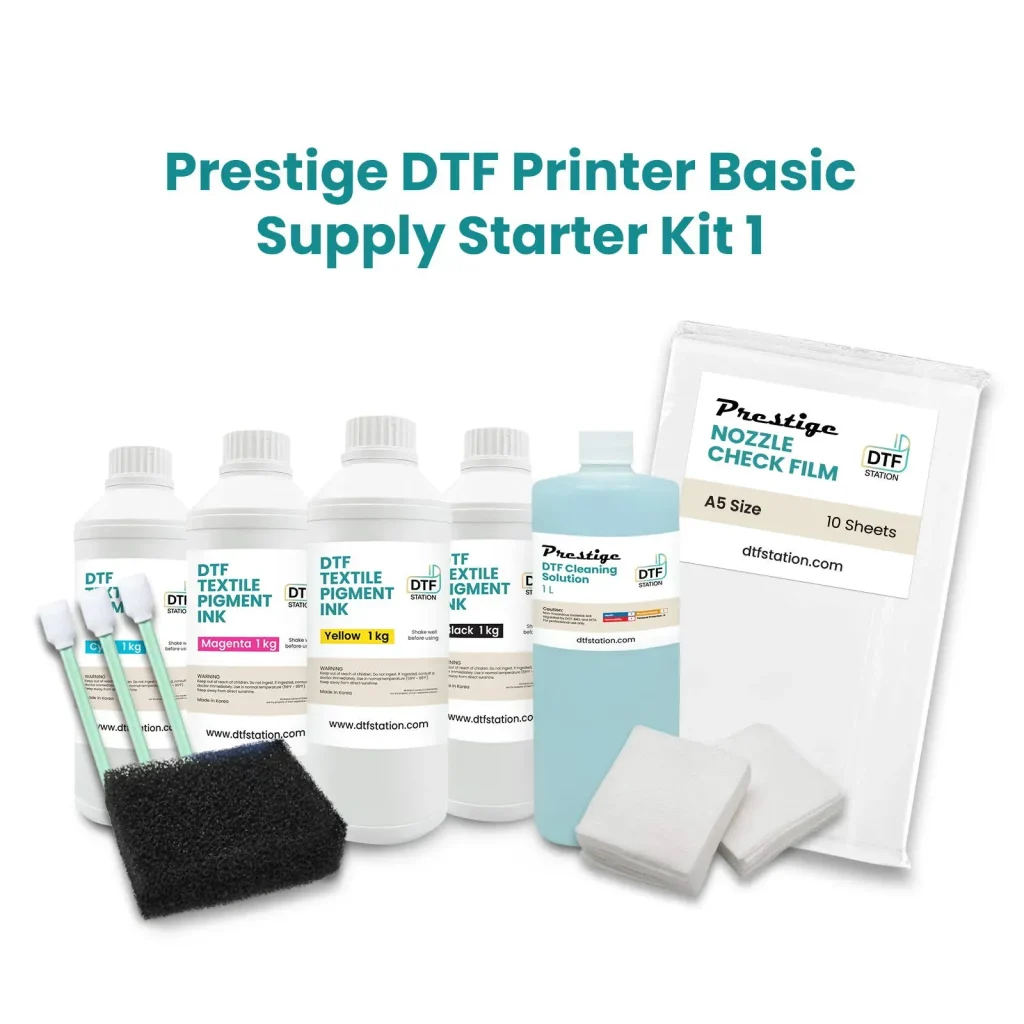DTF Supplies play a pivotal role in the world of Direct-to-Film (DTF) printing, which has transformed the textile printing landscape. This innovative technique empowers aspiring printers to produce stunning, high-quality designs with remarkable efficiency. By utilizing specialized DTF inks and high-quality DTF film, users can achieve vibrant color reproduction and durable prints on a range of fabrics, from cotton to polyester blends. Understanding the essential supplies for DTF printing is critical; these include not only the DTF film and inks but also printers and heat press machines designed for this process. In this guide, we’ll delve into the fundamental components of DTF supplies, equipping newcomers with the knowledge they need to excel in this exciting printing domain.
Exploring the essentials of DTF materials unveils the intricacies behind Direct to Film printing, a technique celebrated for its vivid and enduring media results. This method facilitates the creation of intricate designs by transferring ink through specialized films directly onto various textiles. Aspiring printers are often drawn to the significant advantages this process offers, such as the ease of printing on diverse fabric types without extensive pre-treatment. Among the key components required for effective DTF applications are quality DTF films and inks, which significantly influence the final product’s vibrancy and durability. This article aims to shed light on the foundational supplies integral to mastering the DTF printing technique, ensuring success for those entering this dynamic field.
Understanding the Essentials of DTF Supplies
DTF (Direct to Film) printing represents an innovative shift in how designs are applied to fabrics, yet what truly sets successful operations apart are the essential supplies that underpin this process. The core of DTF printing lies in high-quality DTF film which serves as the canvas for vibrant inks. This film facilitates the transfer of designs onto garments, ensuring clarity, longevity, and resistance to wear and tear. For beginners, selecting the proper film is not just a matter of functionality; it also impacts the aesthetic quality of the prints. High-grade DTF film typically produces brighter colors and clearer images, making it critical for achieving professional results.
In addition to film, another fundamental component of DTF printing is the DTF inks themselves. These specialized inks, generally water-based, not only support environmentally-friendly practices but also offer superb color vibrancy and adhesion properties, essential for successful printing on various fabric types. Investing in quality DTF inks can significantly affect the final output, making it a vital consideration for anyone looking to establish their printing setup. Understanding how these supplies interact within the printing process can help aspiring printers make informed decisions that lead to exceptional finished products.
Choosing the Right DTF Film for Optimal Results
When it comes to DTF printing, the choice of film can make or break the quality of your prints. High-quality DTF film is designed to hold ink effectively, resulting in vibrant and durable designs. There are several options available on the market, and choosing the right one largely depends on the fabric you will be printing on and the specific characteristics you need, such as transparency, thickness, and adhesive capabilities. As a newcomer, researching which types of DTF film yield the best results for your intended projects is crucial.
Furthermore, different brands of DTF film may have unique attributes, including their compatibility with various types of DTF inks. Understanding these interactions is pivotal to avoiding common pitfalls in the printing process, such as ink bleeding or poor transfer quality. Users often share their experiences on community forums, which can provide valuable insights and recommendations for selecting the ideal DTF film that aligns with your creative vision. In essence, investing time in choosing the right film is an essential step towards achieving stunning print results.
The Role of DTF Inks in the Printing Process
DTF inks play a pivotal role in the Direct to Film printing process, acting as the medium that brings designs to life on fabric. Formulated specifically for this technique, DTF inks are typically water-based, promoting a greener printing option while providing exceptional color vibrancy. The chemistry of these inks enables them to bond effectively with the DTF film, ensuring that your designs are not only vibrant but also durable and long-lasting. Whether you’re printing on cotton, polyester, or blends, the right choice of ink directly influences the final print quality.
Moreover, it’s essential for aspiring printers to understand the differences between various types of DTF inks available on the market, as each has its unique characteristics tailored for specific applications. While some inks may provide intense colors, others may offer better wash durability or adherence to certain fabric types. Thorough research and community consultation can help new printers identify the optimal DTF inks for their specific needs, ultimately contributing to more successful printing outcomes.
Selecting the Best Printer for DTF Applications
When venturing into the world of DTF printing, the printer you choose is one of the most significant investments you will make. It’s crucial to select a printer that is compatible with DTF inks and films, as this directly affects the quality and efficiency of your workflows. Many successful DTF users recommend using modified inkjet printers, with brands like Epson and Brother standing out for their adaptability and performance with DTF supplies. Prioritizing compatibility not only ensures better print quality but also enhances your ability to scale production as demand increases.
Additionally, exploring printer modifications is advisable for aspiring DTF printers. These adjustments allow for optimal ink delivery and film handling, which can improve color reproduction and print consistency. Engaging with online communities can provide insights on which printer modifications have proven beneficial, as well as recommendations on specific models that best support your DTF printing objectives. In summary, selecting the right printer is a foundational step toward establishing a successful DTF printing operation.
Current Trends and Innovations in DTF Printing
As DTF printing gains momentum, it is essential to stay updated on the latest trends and innovations shaping the industry. In 2024, many DIY enthusiasts and small businesses are exploring the capabilities of DTF technology, driven by a wealth of online resources and tutorial content. This surge in interest is fostering a vibrant community of creators who share knowledge and experiences, pushing the boundaries of what DTF printing can achieve. Staying attuned to new techniques and best practices shared within this community can enhance your printing capabilities significantly.
Moreover, the supply market for DTF has been expanding with numerous vendors introducing innovative materials—ranging from specialty inks to films designed for specific applications. These advancements allow for greater creativity and versatility in DTF prints, which is particularly exciting for small producers looking to differentiate their products. Keeping an eye on new releases and experiments from fellow printers can lead to exciting opportunities for experimentation and growth within your DTF printing endeavors.
Addressing Common Challenges in DTF Printing
While DTF printing offers numerous benefits, it also presents challenges that many aspiring printers encounter. One common issue is securing the right DTF film or inks that work seamlessly together, as mismatches can lead to unsatisfactory prints. Engaging with communities and forums can help troubleshoot these issues effectively, allowing beginners to learn from the experiences of seasoned printers who have faced and overcome similar hurdles. Sharing solutions can create a supportive environment where knowledge is freely exchanged and fosters growth.
Another significant challenge is maintaining the printing equipment to ensure longevity and consistent output quality. Regular maintenance practices, such as cleaning the print heads and ensuring the printer’s settings are correct, are crucial to achieving the best results. Newcomers are often encouraged to document maintenance schedules and practices to enhance their understanding of equipment care, thereby preventing issues down the line. By addressing these challenges proactively, aspiring printers can improve their overall productivity in the DTF landscape.
Frequently Asked Questions
What are the essential supplies needed for DTF printing?
To get started with DTF printing, you will need some essential supplies including high-quality DTF film, DTF inks specifically formulated for this printing process, a compatible DTF printer (often a modified inkjet printer like Epson or Brother), and a reliable heat press machine to transfer the prints onto the fabric effectively.
How does the DTF printing process work?
DTF printing, or Direct-to-Film printing, involves printing a design onto a special PET film using DTF inks. After the print is completed, a powdered adhesive is applied to the wet ink, which is then cured with a heat press. Finally, the film is transferred onto the garment, allowing for vibrant and long-lasting designs.
What types of ink are used in DTF printing?
DTF inks are specialized inks designed specifically for Direct-to-Film printing. They are typically water-based, which contributes to their environmental sustainability, and are known for providing bright colors and strong adhesion to a variety of fabrics.
Why is choosing the right DTF film important?
Selecting the right DTF film is crucial as it affects the clarity, vibrancy, and durability of the prints. High-quality DTF film helps ensure that your designs withstand regular wear and washing while retaining their detail and color.
What challenges might I face when using DTF supplies?
Common challenges in DTF printing include securing suitable DTF film and achieving print consistency. New users may also encounter issues with equipment maintenance. Utilizing community forums and access to troubleshooting resources can help mitigate these problems and enhance your printing experience.
Can I use regular inkjet printers for DTF printing?
While standard inkjet printers are not designed for DTF printing, modified inkjet printers, particularly from brands like Epson and Brother, can be adapted for DTF applications. It is essential to ensure that the printer supports both DTF inks and film to achieve optimal results.
| Key Points | Description |
|---|---|
| What is DTF Printing? | A textile printing method that transfers ink onto fabric using a film, known for vibrant and durable designs. |
| Advantages of DTF Printing | Simplifies the pre-treatment process, works on various fabrics, offers intricate designs and vivid colors. |
| Essential Supplies | DTF film, DTF inks, compatible printer, and a reliable heat press machine are vital for successful printing. |
| Printer Options | Epson and Brother printers are recommended for their compatibility with DTF supplies and quality output. |
| Current Trends | Growing popularity among DIY enthusiasts and small businesses, with a wider range of DTF supplies available. |
| Challenges | Securing the right supplies and ensuring print consistency can be difficult; solutions include community support. |
| Cost Considerations | Initial investment may be higher, but the efficiency and quality can offset these costs over time. |
Summary
DTF Supplies are essential for anyone looking to delve into the exciting world of Direct-to-Film printing. With its innovative approach to fabric decoration, aspiring printers can achieve stunning results and effectively meet the demands of their projects. Understanding the vital components, like high-quality DTF film, specially formulated DTF inks, compatible printers, and reliable heat presses, sets the stage for successful printing. As trends continue to evolve, keeping abreast of the latest developments in DTF technology and supplies ensures that new entrants can thrive in this dynamic printing landscape, joining a vibrant community committed to creativity and excellence.



